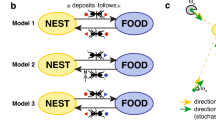Abstract
This paper investigates a class of flocks with an M-nearest-neighbor rule, where each agent’s neighbors are determined according to M nearest agents with M being a given integer, rather than all the agents within a fixed metric distance as in the well-known Vicsek’s model. Such a neighbor rule has been validated by biologists through experiments and the authors will prove that, similar to the Vicsek’s model, such a new neighbor rule can also achieve consensus under some conditions imposed only on the system’s speed and the number M, n, without resorting to any priori connectivity assumptions on the trajectory of the system. In particular, the authors will prove that if the number M is proportional to the population size n, then for any speed v, the system will achieve consensus with large probability if the population size is large enough.
Similar content being viewed by others
References
Vicsek T, Czirok A, Jacob E B, et al., Novel type of phase transition in a system of self-driven particles, Phys. Rev. Lett., 1995, 75: 1226–1229.
Cucker F, Smale S, Emergent behavior in flocks, IEEE Trans. Autom. Control, 2007, 52(5): 852–862.
Reynolds C, Flocks, herds, and schools, a distributed behavioral model, Computer Graphics, 1987, 21: 25–34.
Ballerini M, Cabibbo N, et al., Interaction ruling animal collective behavior depends on topological rather than metric distance: Evidence from a field study, PNAS, 2008, 2008(4): 1232–1237.
Xue F and Kumar P R, The number of neighbors needed for connectivity of wireless networks, Wireless Network, 2004, 10: 169–181.
Balister P, Bollobás B, Sarkar A, and Walters M, Connectivity of random k-nearest-neighbour graphs, Advances in Applied Probability, 2005, 37(1): 1–24.
Tang G G and Guo L, Convergence of a class of multi-agent systems in probabilistic framework, Journal of Systems Science and Complexity, 2007, 20(2): 173–197.
Jadbabaie A, Lin J, and Morse A S, Coordination of groups of mobile autonomous agents using nearest neighbor rules, IEEE Trans. Autom. Control, 2003, 48(9): 988–1001.
Savkin A V, Coordinated collective motion of groups of autonomous mobile robots: Analysis of Vicsek’s model, IEEE Trans. Autom. Control, 2004, 39(6): 981–983.
Ren W and Beard R W, Consensus seeking in multiagent systems under dynamically changing interaction topologies, IEEE Trans. Autom. Control, 2005, 50(5): 655–661.
Moureau L, Stability of multiagent systems with time-dependent communication links, IEEE Trans. Autom. Control, 2005, 50(2): 169–181.
Liu Z X and Guo L, Synchronization of multi-agent systems without connectivity assumption, Automatica, 2009, 45: 2744–2753.
Liu Z X and Guo L, Connectivity and synchronization of multi-agent systems, Science in China, 2008, 51(7): 848–858.
Olfati-Saber R, Flocking for multi-agent dynamic systems: Algorithms and Theory, IEEE Trans. Autom. Control, 2006, 51(3): 401–420.
Tang G G and Guo L, Convergence analysis of linearized Vicsek’s model, Proceedings of the 25th Chinese Control Conference, 2006, 379–382.
Chen G, Liu Z X, and Guo L, The smallest possible interaction radius for flock synchronization, SIAM J. CONTROL OPTIM., 2012, 50(4): 1950–1970.
Wang L, Wang X F, and Hu X M, Synchronization of multi-agent systems with topological interaction, Proceedings of the 18th IFAC World Congress, Milano, Italy, 2011.
Chen C, Chen G, and Guo L, Synchronization of mobile autonomous agents with M-nearestneighbor rule, Proceedings of the 25th Chinese Control Conference, Xi’an, China, 2012.
Shaw E, Fish in schools, Natural History, 1975, 84(8): 40–46.
O’Brien D P, Analysis of the internal arrangement of individuals within crustacean aggregations, J. Exp. Mar. Bio. Eco., 1989, 128(1): 1–30.
Okubo A, Dynamical aspects of animal grouping: Swarms, schools, flocks and herds, Adv. Biophys., 1986, 22: 1–94.
Parrish J K, Viscido S V, and Grunbaum D, Self-organized fish schools: An examination of emergent properties, Biol. Bull., 2002, 202: 296–305.
Penrose M D, Random Geometric Graphs, Oxford University Press, Oxford, UK, 2003.
Author information
Authors and Affiliations
Corresponding author
Additional information
This work is supported by the National Natural Science Foundation (NNSF) of China under Grant No. 61203141 and the National Center for Mathematics and Interdisciplinary Sciences, Chinese Academy of Science.
This paper was recommended for publication by Editor HAN Jing.
Rights and permissions
About this article
Cite this article
Chen, C., Chen, G. & Guo, L. Consensus of flocks under M-nearest-neighbor rules. J Syst Sci Complex 28, 1–15 (2015). https://doi.org/10.1007/s11424-015-3048-x
Received:
Revised:
Published:
Issue Date:
DOI: https://doi.org/10.1007/s11424-015-3048-x




